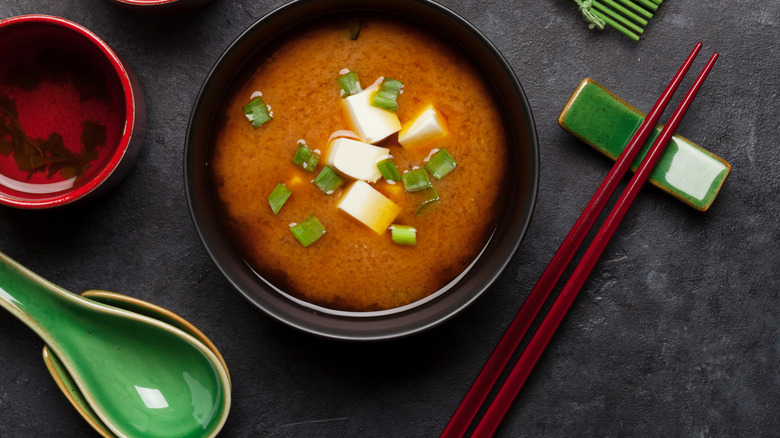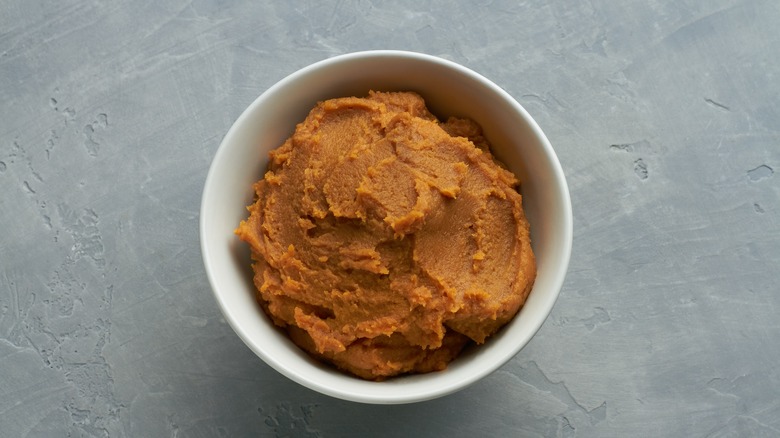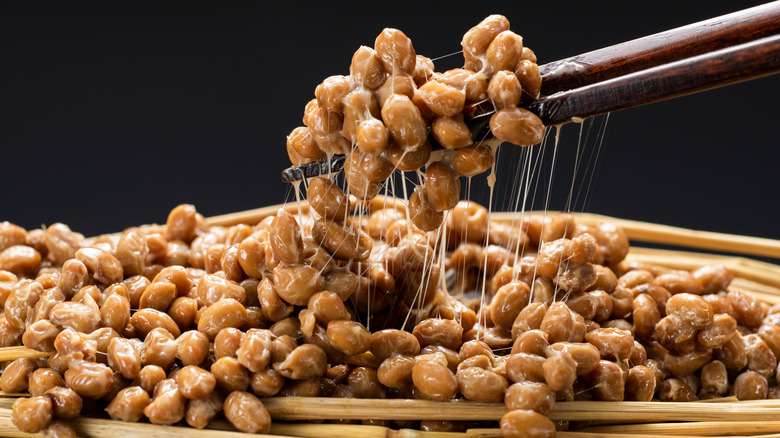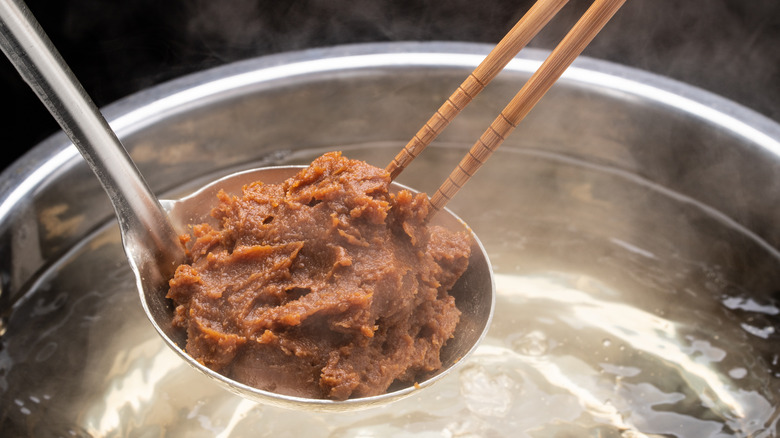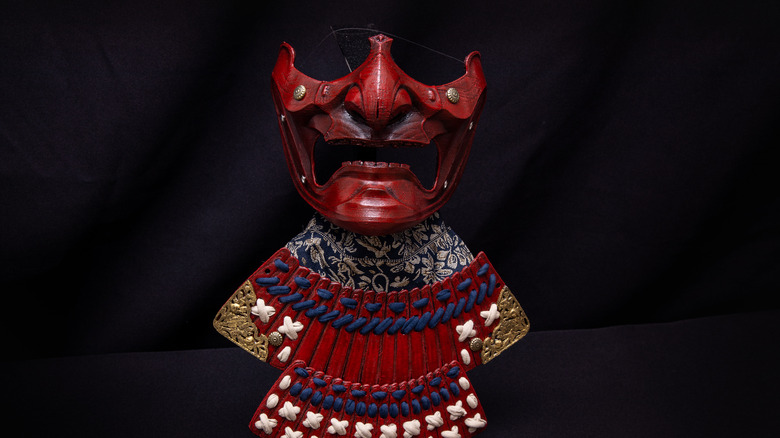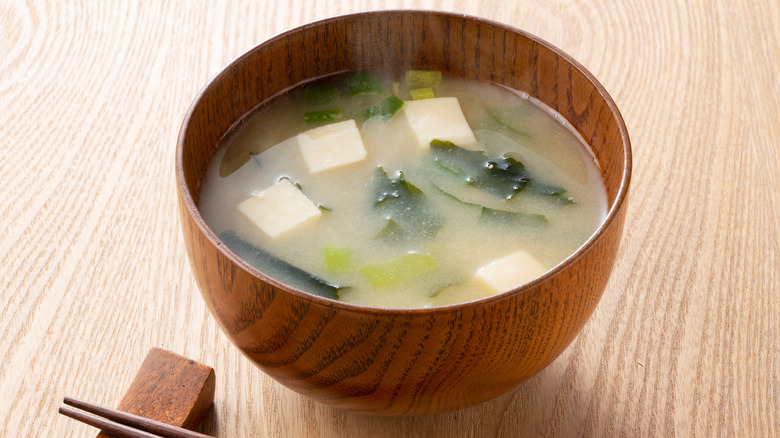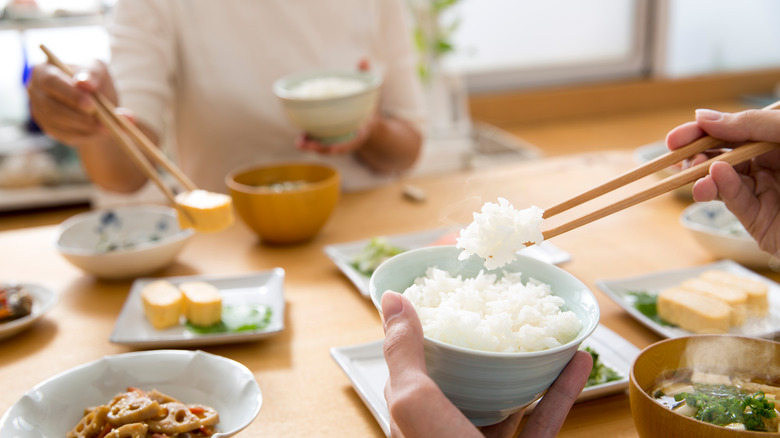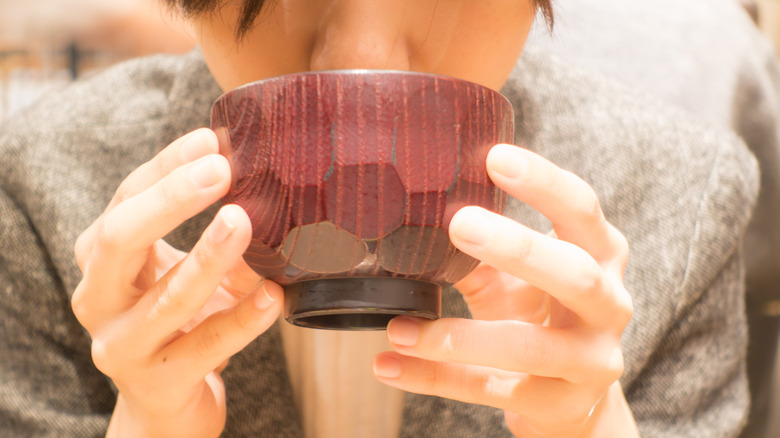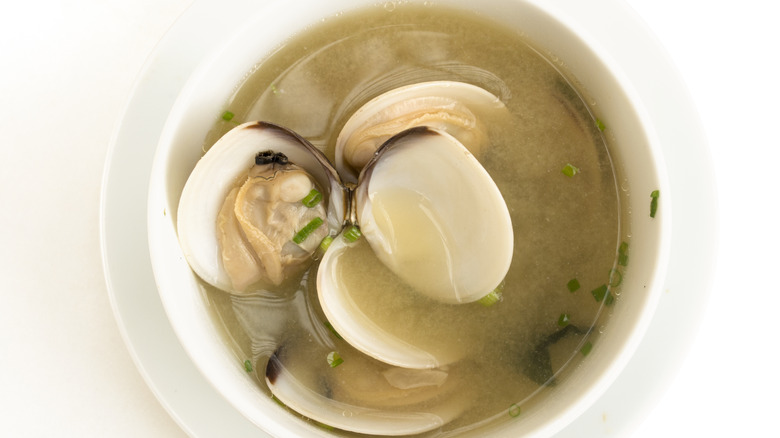The Untold Truth Of Miso Soup
If you've ever been to a sushi place or a Japanese restaurant in the U.S., you've likely been offered a portion of miso soup as an appetizer, either instead of or alongside a salad with a zesty ginger-orange dressing. But did you know that miso soup isn't traditionally served as an appetizer at all, but as a snack with sake or as part of the main meal, to be mixed with steamed vegetables or fish, and served with rice? (as per Just One Cookbook). Or that miso soup was once a luxury only consumed by Japan's wealthiest nobles? (via MisoTasty).
These facts are just a few of the many things you may not have known about this Japanese specialty. Miso is rich in nutrients and has numerous health benefits. With a history dating back hundreds of years, miso's omnipresence and popularity are unparalleled in Japan. Miso has strong links to Japan's famous samurai and is governed by very specific rules of etiquette. Miso soup boasts a long history and culture that are ripe for discovery.
Miso soup is made with miso and dashi
Miso soup's name clues you into just one of its main ingredients. Miso soup is, indeed, made with miso paste. Recipes for miso paste tend to combine soybeans with grains such as rice or barley, salt, and koji, which is a mold that ferments the other ingredients.
However, this simple formula is also highly varied. Japan is home to more than a thousand types of miso, which differ by region and may feature different proportions of ingredients with longer or shorter fermentation times. In the U.S., different miso pastes are often sold based on their color (light or dark). Whichever kind of miso paste you select, it generally has a sweetish, mildly funky texture. Darker miso pastes tend to have a stronger taste.
Miso soup also contains a second, highly important ingredient: According to Kobe Jones, dashi is a fish stock made from dried sardines, dried seaweed, and smoked bonito shaving or dried shiitake mushrooms. Dashi lends quite a bit of flavor to the soup. In addition to these two major ingredients, miso soup may also contain other add-ins like onions, tofu, spinach, mushrooms, egg, or even fish or shellfish.
Miso soup is rich in health benefits
If miso has long been used as both a food and medicine in Japan, it's no doubt due to its phenomenal nutritional characteristics (via Just One Cookbook). According to BBC Food, miso paste has a bevy of benefits. It is rich in protein (2 grams for just 1 tablespoon of miso paste). Miso provides powerful, phenomenal gut health support due to its bacterial fermentation. Studies indicate that beneficial gut bacteria may be able to produce certain vitamins (notably K and B12), which means that consuming miso could help you fulfill your nutrient needs. Miso may also support brain health.
According to Healthline, evidence shows that regular consumption of miso may reduce the risk of certain cancers, including stomach cancer. It might also boost your immune system. It's no wonder that miso has been such a popular Japanese staple for such a long time!
Miso was not originally consumed in soup form
Miso is fast becoming more popular in the U.S. These days, it is used in everything from salad recipes to sweet cookies and more, though for many Americans, miso soup may be their first — if not their only — brush with the staple Japanese ingredient. But while miso soup may well be the most common way to consume miso in America today, historically speaking, it's far from the most traditional way of enjoying the fermented soybean product.
According to Just One Cookbook, the earliest Japanese miso was not in paste form at all. Instead, the soybeans were dried and salted and then used whole, as a seasoning for vegetables, fish, or rice. They were also used as a home remedy for various ailments. The creation of miso paste — which wouldn't be invented until the Kamakura period — was an essential first step in the creation of miso soup.
Miso soup was invented during the Kamakura period
Miso has been around since ancient times, according to Just One Cookbook, which cites ancient China as its place of origin. It may have arrived in Japan in the sixth century by way of Buddhist monks, though some other sources claim that miso actually existed in Japan as early as the Yayoi period (300 B.C. to A.D. 300).
The oldest written record of miso dates back to the Heian period (A.D. 794-1185), although a fermented soybean product of some kind certainly existed before this time. At the time, it was perceived as a luxury food, to be enjoyed exclusively by nobles, and it had not yet transformed into a paste; that development came about during the Kamakura period (A.D. 1185-1333) when monks studying in China returned to Japan with one essential tool — the mortar and pestle. This allowed them to crush the fermented soybeans into a paste, which could then be dissolved in hot water, and thus, miso soup was born.
Samurai warriors used taro stems to create instant miso
While the use and consumption of miso was initially restricted to the nobility, this changed during the Sengoku period (A.D. 1467-1568) (via Marukome). During this period of time — dubbed the "warring states" period — samurai warriors began taking miso with them for sustenance when heading into battle. According to Just One Cookbook, they sported belts made of dried taro stems that had previously been immersed in hot miso. They would either eat the taro sticks at they were, or pour boiling water over them to create instant miso.
The samurai promoted the production of different types of miso depending on their region of origin. As per Britannica, Takeda Shingen was one of the most famous military leaders and feudal lords in Japanese history. He encouraged the production of Shinshu miso, which, as per Bon Appétit, is referred to as yellow miso in English. This fairly mild variety is fermented a bit longer than white miso, or Shiro miso.
Others samurai, such as Date Masamune and Oda Nobunaga, promoted Sendai and Hatcho miso respectively. Sendai, according to Umamimart, is made with rice kōji and soybeans and boasts a long fermentation but nevertheless has a mild flavor. Clearspring notes that Hatcho miso is made with soybeans and barley flour and is dark and rich in color and flavor.
Miso soup consumption became widespread during the Edo period
Miso was very popular among nobility and samurai before the Edo period, also known as the Tokugawa period, which lasted from 1603 to 1867 (via Just One Cookbook). During the Edo period, the growing population of Edo (now called Tokyo) led to a short supply of miso. Miso was brought in from the surrounding regions to respond to this increasing demand.
As a result, many different types of miso became widely available in Edo at the time. As per Marukome, due to the wide varieties of miso available in the city at the time, miso – and miso soup — were finally integrated into the diets of Japan's poorer citizens.
Local miso, called Edo, also became particularly popular, thanks to its relatively quick turnaround time in terms of production to consumption. Indeed, Edo miso was not a long-fermented product but was rather fresh, with a shelf life of just 10 days during summer.
Most Japanese people eat miso soup every day
These days, miso soup is far from the luxury item it once was in Japan. Indeed, according to Kobe Jones, approximately three-quarters of Japanese citizens eat miso soup at least once a day, a feat rendered even easier, as Serious Eats notes, by the preponderance of freeze-dried dashi powder. Japanese people enjoy miso soup, not as an appetizer, as it often is in Western sushi restaurants, but as an accompaniment to steak, rice, or sashimi. As per Blue Zones, many also enjoy miso soup for breakfast.
Miso soup is an integral part of many Japanese mealtimes. Nevertheless, Just One Cookbook asserts that miso production is actually on the decline in Japan, from 15 kilograms in 1970 to just 7.2 kilograms in 2008. Miso production nationwide has fallen by 40% over the last 50 years. While Japan's overall miso production has decreased, exports have risen tenfold from 1977 to 2012, indicating miso's growing international popularity.
There is an etiquette to drinking miso soup
According to Kokoro, miso soup has a few specific rules surrounding its consumption. First and foremost, miso soup is not usually eaten with a spoon. Instead, the soup is traditionally sipped from the bowl. When sipping the broth base, the bowl should be held with both hands: Your non-dominant hand should be used to support the bowl from the bottom, while your dominant hand holds the side of the bowl.
Any solid pieces in the bowl, such as tofu or seaweed, should be eaten with chopsticks. As Food and Nutrition points out, it is perfectly acceptable to bring the bowl close to your face for greater ease in picking food via chopsticks. In fact, as per RecipeTin Japan, it's considered rude to not lift the bowl from the table while eating from it.
Additionally, if your miso soup comes with a lid that's difficult to remove, it can be pinched slightly to break the vacuum seal that occasionally forms as a result of the steam from the soup. This lid should never be flipped over when it is removed or replaced.
The ingredients in miso soup can vary depending on region
Considering its pervasive place in Japanese cuisine and culture, it's should come as no surprise that there are many different recipes for miso soup. The soup, Kokoro asserts, often varies by region. Ingredients in different kinds of miso soup are dependent on the availability of local ingredients specific to the particular region from which they originate. Different areas of Japan will add different kinds of vegetables and protein to the broth.
Ayano, from Chiba prefecture, tells Kokoro that their family's miso soup includes tofu, wakame seaweed, and Japanese radish. An interviewee from Hokkaido prefecture, Shunsuke, notes that their simple family recipe included mushrooms includes mushrooms. Hiroshima prefecture resident Ayane, whose parents hail from Nagoya prefecture explains that their family's miso soup uses local red miso and add-ins like mussels or eggplant. Yuri shares that their family in Fukui prefecture used a unique local ingredient called uchimame, made from pressed and dried soybeans.
